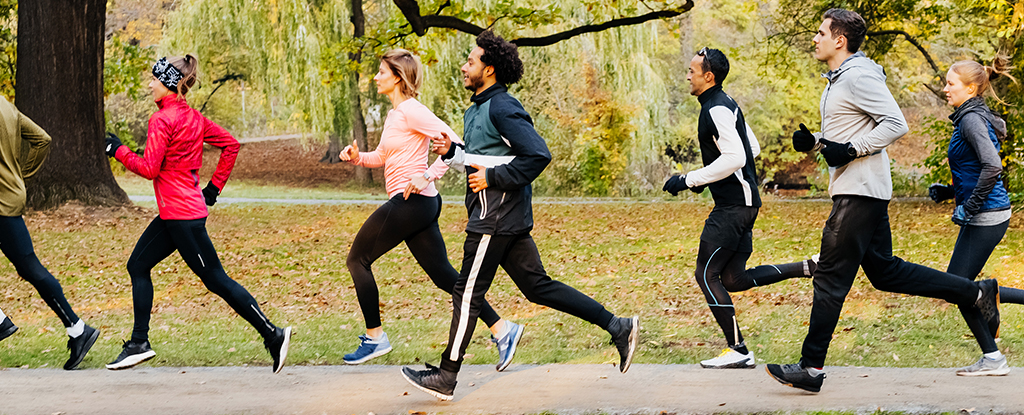Runners are obsessed with time. Amateur or professional, for most avid runners the aim is to get faster – constantly training in order to shave even just a couple of seconds off their marathon time or 5K pace.
But one running trend that’s started to gain a foothold in recent years is that of “slow running”. The idea behind the slow running movement is that anyone can run – no matter your ability or how fast you run.
Fans of this approach say it has many benefits – not just for your health but also in how enjoyable you find running. Research agrees, with evidence showing slow running may in some ways be more beneficial than training at higher intensities.
When we think of elite runners such as Eliud Kipchoge or Kelvin Kiptum, we might assume that to set world records, they primarily train at these record-setting paces.
But surprisingly, elite runners spend around 80 percent of their time training at what’s termed zone 2 running – a running pace which raises your heart rate, but is still slow enough that you can hold a conversation. Only around 20 percent of their training is done in the higher intensity zones, which are closer to their race pace.
The reason for this relates to the amount of stress that training puts on the body. As running speed increases, the more strain the body is put under. The more strain the body is put under, the greater a person’s risk of illness, infection and injury.
By reducing the amount of time they spend at higher intensities, athletes limit their chances of missing out on training due to illness and injury.
But there’s more to this approach than just reducing the risk of injury and illness. A fundamental aspect of training is developing what’s known as “base”. This term describes the physiological foundations that underpin all training adaptations. For the endurance runner, this refers to their baseline cardio-respiratory fitness on to which their higher intensity adaptations can be built.
Think of it like a pyramid, which has a solid base on which the rest of the structure is built. The bigger the base, the taller the pyramid can be.
The same holds true for training. The better your base, the more capable you will be when working at higher intensities.
Your base is developed during slow (zone 2) running, where physiological stress is relatively low. But even though the heart isn’t under very much stress during zone 2 running, the amount of oxygenated blood leaving the heart each beat will be close to or at its maximum amount.
This is important because while the pumping capacity of the heart adapts to training, higher intensities do not increase this gain. Developing a strong base allows for more oxygen to be delivered to the working muscles per heartbeat, which is crucial to running success.
Not only that, but running at slow paces causes the body to use stored fat for energy – as opposed to relying on carbohydrate stores that come from the foods we eat.
Burning fat is metabolically a far more efficient process, as the amount of energy derived from a single molecule of fat far exceeds the amount from a molecule of carbohydrate. This means runners will use less energy overall – and will be less fatigued and better able to run fast on race day.
Studies have shown that gains in VO2 max (oxygen capacity) and race speed are around 1 percent greater for athletes who spend more time slow running. Crucially, the gains in aerobic base are around five times greater in slow runners compared to athletes who more frequently use high-intensity runs.
Even if you aren’t an athlete, aiming to keep most of your runs at a low intensity may still be optimal.
Slow and steady
If you’re keen to give slow running a try, the most important thing is your pace. How exactly do you know you’re at the right speed to be classed as slow running?
Some scientists divide running pace into five or six different zones. Physiologically, zone 2 is defined as occurring below the lactate threshold – the point where lactate (an acid the body produces when it begins to burn carbohydrates for energy) first starts to appear in the blood.
In simple terms, this should be at a speed where you can still hold a conversation and your heart rate is only around 70 percent of your maximum. If you find conversation starts to become difficult then you should slow your pace down.
If you’re running on your own, you can try the talk test. If you can sing out loud to yourself without struggling to catch your breath, you’re in the right zone. If you do struggle, you’re at too high an intensity and lactate will start to build up in your muscles (which may make your legs feel heavy).
Slow running offers many benefits – both for your body and your mental health. So if you’re someone who’s always been shy about your slow running pace, perhaps this will inspire you to put on your trainers and give running a go.
Dan Gordon, Associate Professor, Cardiorespiratory Exercise Physiology, Anglia Ruskin University; Jonathan Melville, PhD Candidate, Sport and Exercise Science, Anglia Ruskin University, and Matthew Slater, PhD Candidate, Anglia Ruskin University
This article is republished from The Conversation under a Creative Commons license. Read the original article.





